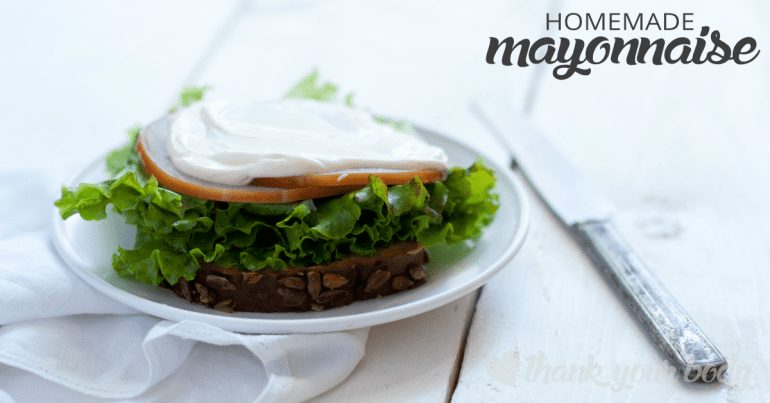To be honest, I’ve never really paid much attention to mayonnaise.
In fact, it’s never really been high on the list of foods I enjoy. It’s just so…mayonnaise-y. But recently I’ve discovered: Not all mayonnaise is created equal! While I’m not a fan of the mayo I used to buy at the store, I’ve discovered that mayonnaise made from organic, natural ingredients made at home is a different story entirely. Creamy, rich and thick, homemade mayonnaise has made me change my mind about mayo altogether! No more “Hold the mayo” for me. Free-range eggs, organic extra virgin olive oil and a little organic apple cider vinegar make this condiment not only delicious, but also good for you!
A Better Mayo
Traditional mayo is usually made of soybean oil, along with a host of additives and preservatives. Searching for a better option, I started buying mayonnaise made “with olive oil” instead. My family actually did notice the difference, and we all thought the olive oil mayo was an improvement. Then one day I got suspicious: “Wait a minute,” I thought. “What exactly does ‘with olive oil’ mean?” Sure enough, a closer look at the label revealed that, while olive oil was indeed first on the list, the store-bought bottle of mayonnaise also contained canola oil and soybean oil! I should have known better. Lesson learned: Always read the whole label before putting that item in your cart! I’ve learned that mayonnaise is only as good as its ingredients.
One ingredient in mayonnaise is eggs. Use organic free range eggs. These are twice as high in Omega-3 as other eggs, and also have a higher vitamin content (to say nothing of how much better it is for the chicken!). Many homemade mayonnaise recipes call for just egg yolks, but in this one whole eggs are used–giving you all the protein and B vitamins that egg whites contain. Put your eggs in a food processor along with powdered mustard and salt, and puree. Add some vinegar; rather than distilled white vinegar, use organic apple cider vinegar…preferably one that contains “the Mother” (living strands of enzymes). You can find it here.
The main ingredient in mayo is actually oil, so if you’re going to eat mayonnaise you need to be aware of what sort of oil you’re consuming. Read this article to learn more about which oils are good to cook with and which should be avoided. Rather than rancid canola oil or GMO-laden soybean oil, use organic cold pressed extra-virgin olive oil in your homemade mayonnaise. You’ll be getting the benefits of Omega-3 as well as possible benefits to your heart and blood. Yes, olive oil is high in fat…but it’s the good kind, so you may as well put those calories to work for you! Once your other ingredients are pureed, add your oil. It’s important to drizzle the oil in a tiny bit at a time, very slowly. I like to use a funnel to add the oil, because it cuts down on the amount of mayo that flies out of the food processor as you work! Process until the mayonnaise thickens, then put it in a canning jar and store in the fridge. Fast and easy!
Heart-healthy Omega-3, active enzymes, protein and vitamins. Hold on here…suddenly, mayonnaise is sounding like a health food! Just wait ’till you taste it. You’ll never look at mayo the same again!
- 2 organic, free range eggs
- 2 Tablespoons organic apple cider vinegar with the Mother (
- In a food processor, blend eggs, apple cider vinegar, mustard and sea salt. Pulse until combined.
- With the food processor going, slowly drizzle the oil into the egg mixture. You need to do this slowly, make sure that only a thin stream of oil is going in. If you're doing it right, you will probably have to set the measuring cup down at least once because your arm will get tired!
- Continue to run the food processor until the mayonnaise thickens. If your mayo isn't thick enough, add a little more oil and process it longer.
- Spoon the mayonnaise into a canning jar, secure the lid and store it in the fridge for up to two weeks.
Looking for more delicious real food recipes? I’ve got your back!
I’ve put together 85 incredible dishes that are full of flavor, super yummy, and good for you, too. From main dishes to desserts (and everything in between) you’ll have some fun new eats that I know you’ll love.
Best part? The ebook is only 2 bucks. It’s a total no-brainer, right? Right. Click here to check it out.
Do you like mayonnaise? Have you ever tried making it at home?
Photography by Jennifer Leung Johnson
[/fusion_builder_column][/fusion_builder_row][/fusion_builder_container]SIGN UP FOR FREE UPDATES, OFFERS, & TIPS.
Plus I'll send you a free copy of "Your Simply Healthy Handbook." It's your #1 resource to make healthy living easy.
Thank you for supporting this site with purchases made through links in this article.






